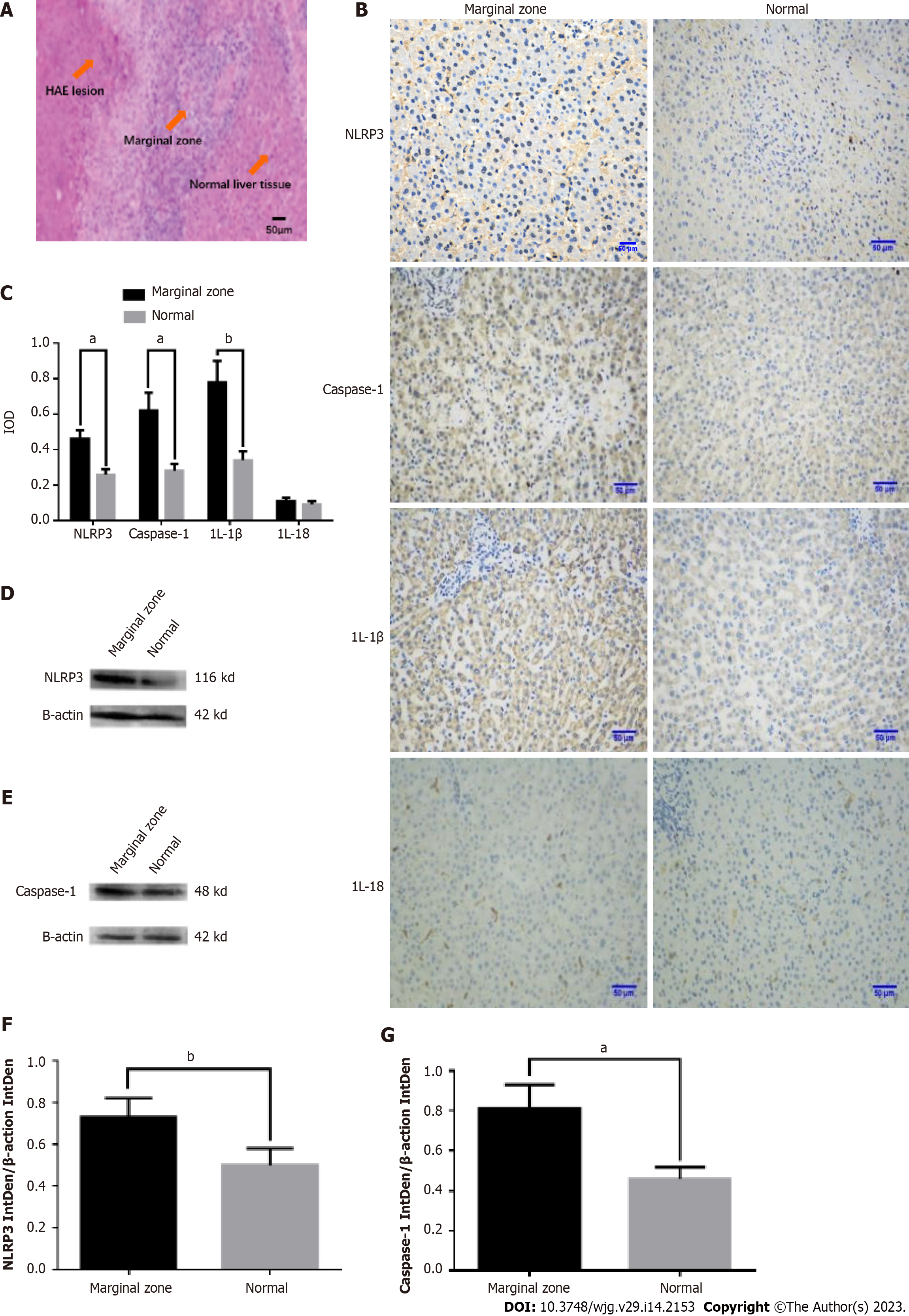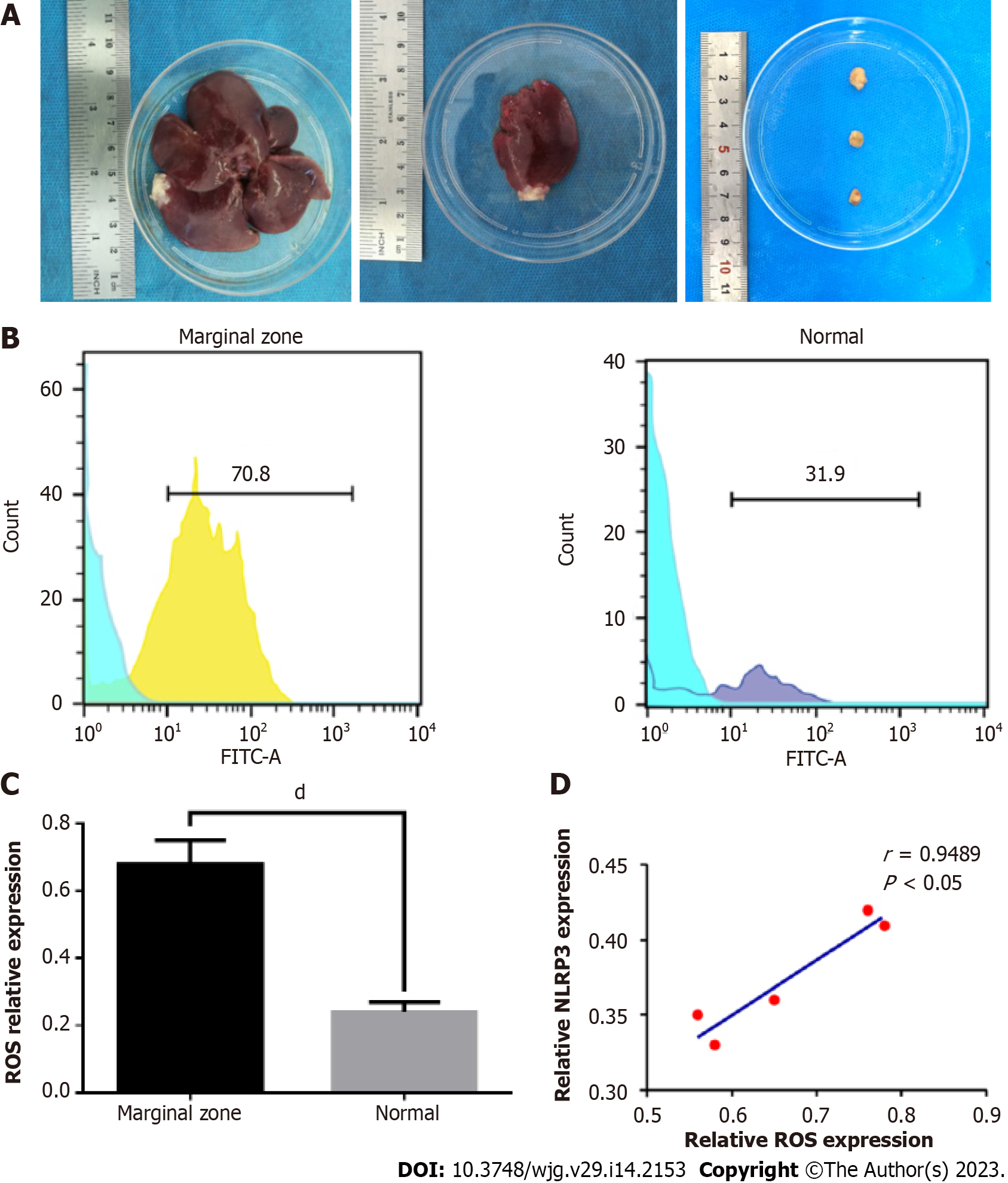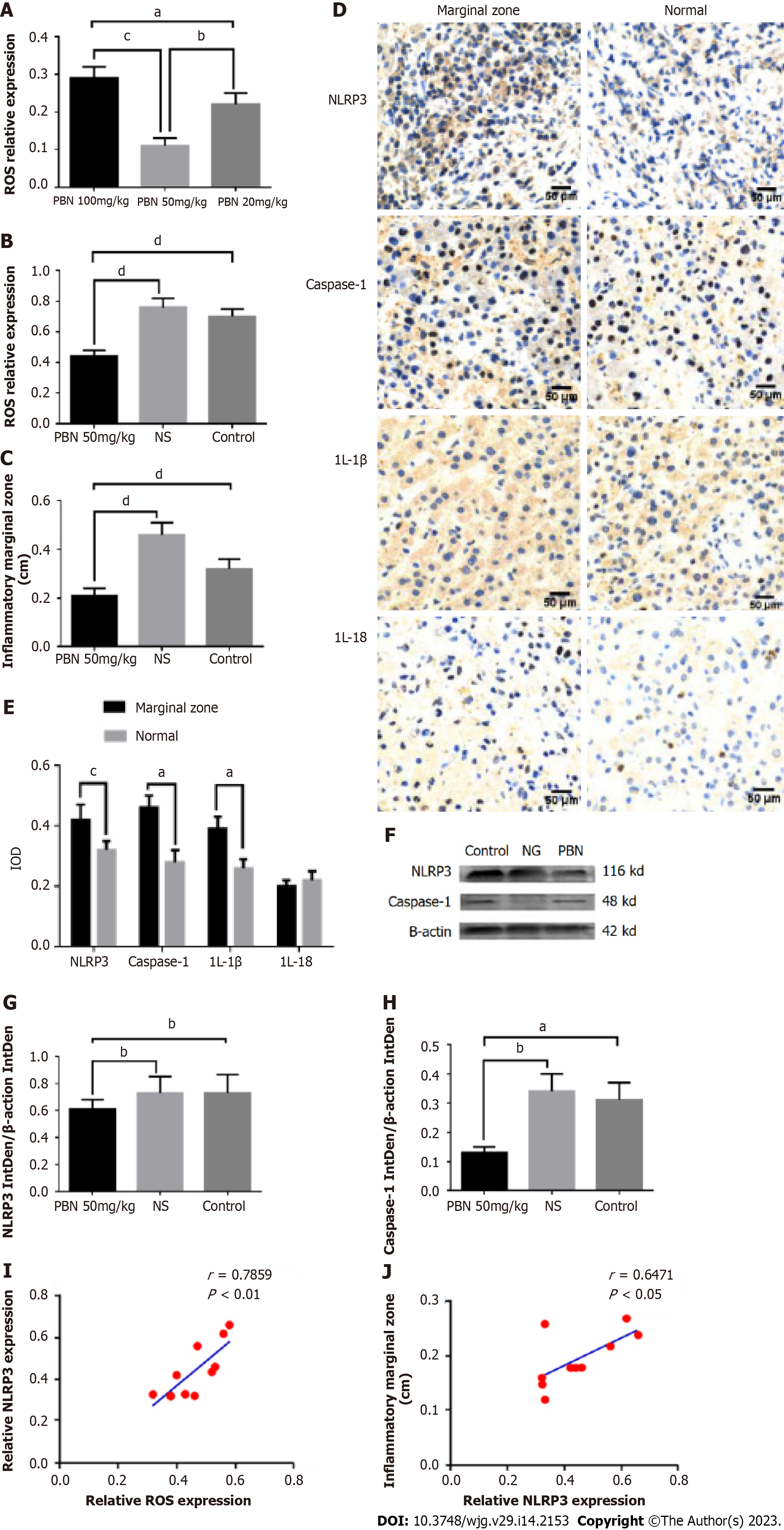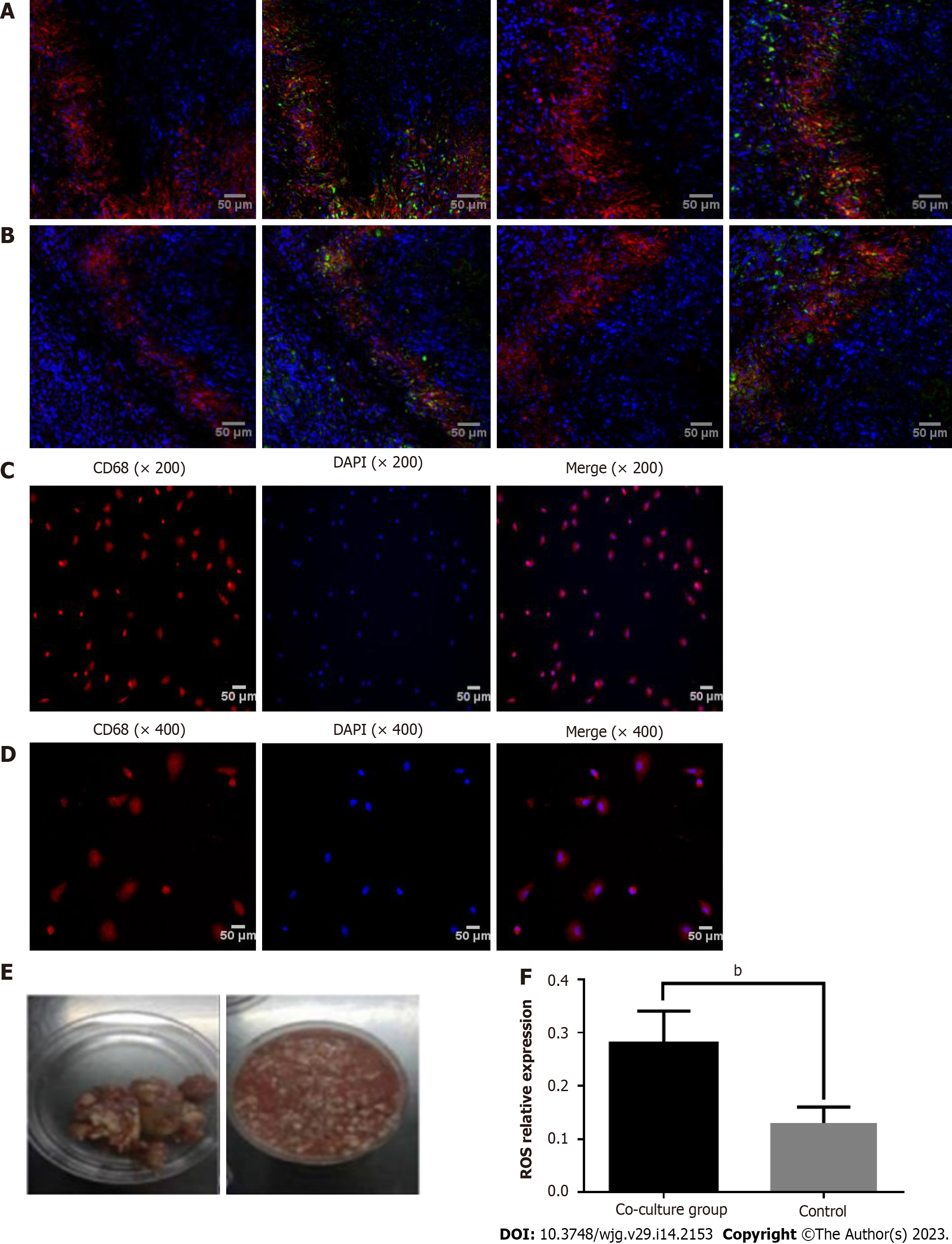Copyright
©The Author(s) 2023.
World J Gastroenterol. Apr 14, 2023; 29(14): 2153-2171
Published online Apr 14, 2023. doi: 10.3748/wjg.v29.i14.2153
Published online Apr 14, 2023. doi: 10.3748/wjg.v29.i14.2153
Figure 1 NOD-like receptor family pyrin domain-containing 3, caspase-1, and interleukin-1β were upregulated in the marginal zone and NOD-like receptor family pyrin domain-containing 3 expression was associated with hepatic alveolar echinococcosis.
A: Hematoxylin and eosin staining of the lesion, marginal zone, and corresponding normal liver in hepatic alveolar echinococcosis; B: Immunohistochemical staining of NOD-like receptor family pyrin domain-containing 3 (NLRP3), caspase-1, interleukin (IL)-1β, and IL-18 in the marginal zone and corresponding normal liver; C: Relative expression of NLRP3, caspase-1, IL-1β, and IL-18; D: NLRP3 protein expression evaluated by western blotting; E: Caspase-1 protein expression evaluated by Western blotting; F: Relative protein expression levels of NLRP3 IntDen/β-actin IntDen; G: Relative protein expression levels of caspase-1 IntDen/β-actin IntDen. C, n = 60. Scale bar: 50 μm. Western blotting was performed in triplicate (mean ± SD). aP < 0.05; bP < 0.01. HAE: Hepatic alveolar echinococcosis; IOD: Integral Optical Density; NLRP3: NOD-like receptor family pyrin domain-containing 3. IL-1β: Interleukin-1β; IL-18: Interleukin-18.
Figure 2 Reactive oxygen species were highly produced in the hepatic alveolar echinococcosis marginal zone and were intimately associated with the activation of NOD-like receptor family pyrin domain-containing 3.
A: Lesion growth in hepatic alveolar echinococcosis rats; B: Reactive oxygen species (ROS) production in the marginal zone and corresponding normal liver; C: Relative levels of ROS production; D: Relationship between ROS and NLRP3. C and D, n = 5 rats per group. dP < 0.0001. NLRP3: NOD-like receptor family pyrin domain-containing 3; ROS: Reactive oxygen species; FITC-A: Fluorescein isothiocyanate isomer I-A.
Figure 3 Reactive oxygen species-mediated NOD-like receptor family pyrin domain-containing 3 inflammasome activation in hepatic alveolar echinococcosis rats.
A: Reactive oxygen species (ROS) production in the 20, 50, and 100 mg/kg/d N-tert-Butyl-α-phenylnitrone (PBN) groups; B: ROS production in the 50 mg/kg/d PBN, normal saline (NS), and control groups; C: Analysis of inflammation; D: Immunohistochemical staining of NLRP3, caspase-1, interleukin (IL)-1β, and IL-18; E: Relative expression of NLRP3, caspase-1, IL-1β, and IL-18 in the marginal zone compared with the corresponding normal liver; F: Western blotting analysis of the PBN, NS, and control groups; G: NLRP3 IntDen/β-actin IntDen protein expression; H: Caspase-1 IntDen/β-actin IntDen protein expression; I: Relationship between ROS production and the relative expression of NLRP3; J: The relative expression of NLRP3 and inflammation observed in the marginal zone. Western blotting was performed in triplicate (mean ± SD). Scale bar, 50 μm. A, n = 3 rats per group; B, C, and E, n = 10 rats per group; I and J, n = 10. aP < 0.05; bP < 0.01; cP < 0.001; dP < 0.0001. NLRP3: NOD-like receptor family pyrin domain-containing 3; ROS: Reactive oxygen species; PBN: N-tert-Butyl-α-phenylnitrone; NS: Normal saline; IOD: Integral optical density; IL-1β: Interleukin-1β; IL-18: Interleukin-18.
Figure 4 Echinococcus multilocularis activation of the NOD-like receptor family pyrin domain-containing 3-caspase-1-interleukin-1β pathways in Kupffer cells.
A: Cellular localisation of NOD-like receptor family pyrin domain-containing 3 (NLRP3) in the marginal zone (red denotes NLRP3 inflammasomes, blue denotes 4’,6-diamidino-2-phenylindole (DAPI) stained nuclei, and green denotes the macrophage marker, CD68); B: Cellular localisation of caspase-1 in the marginal zone (red denotes caspase-1, blue denotes DAPI stained nuclei, and green denotes CD68); C: The identification of Kupffer cells at 200 × magnification and; D: The identification of Kupffer cells at 400× magnification (red denotes CD68 and blue denotes DAPI stained nuclei; the final image is a fusion image); E: Isolation of E. multilocularis; F: Relative expression in the co-culture and control groups. Scale bar, 50 μm. F, n = 3. bP < 0.01. NLRP3: NOD-like receptor family pyrin domain-containing 3; DAPI: 4’,6-diamidino-2-phenylindole.
Figure 5 Reactive oxygen species-mediated NOD-like receptor family pyrin domain-containing 3-caspase-1-interleukin-18 pathway activation in Kupffer cells.
A: Reactive oxygen species (ROS) production with the indicated N-acetyl-L-cysteine (NAC) dose at the specified time points. bP < 0.01, blank vs 5 mmol/L; aP < 0.05, 10 mmol/L vs 5 mmol/L. bP < 0.0120 mmol/L vs 5 mmol/L; B: Representation of the Transwell model used in this study; C: ROS production in the co-culture groups treated with or without NAC at the indicated time points; D: Relative production of ROS; E: Interleukin (IL)-18 expression; F: IL-1β expression; G: Apoptosis of hepatocytes in the co-culture groups treated with or without NAC at 24, 48, and 72 h; H: Cell viability; I: Western blotting analysis of the indicated proteins; J: NLRP3 IntDen/β-actin IntDen protein expression; K: Caspase-1 IntDen/β-actin IntDen protein expression. aP < 0.05; bP < 0.01. NLRP3: NOD-like receptor family pyrin domain-containing 3; ROS: Reactive oxygen species; FITC-A: Fluorescein isothiocyanate isomer I-A; PI: Propidium Iodide; NAC: N-acetyl-L-cysteine; IL-1β: Interleukin-1β; IL-18: Interleukin-18.
- Citation: Chen CS, Zhang YG, Wang HJ, Fan HN. Effect and mechanism of reactive oxygen species-mediated NOD-like receptor family pyrin domain-containing 3 inflammasome activation in hepatic alveolar echinococcosis. World J Gastroenterol 2023; 29(14): 2153-2171
- URL: https://www.wjgnet.com/1007-9327/full/v29/i14/2153.htm
- DOI: https://dx.doi.org/10.3748/wjg.v29.i14.2153

















